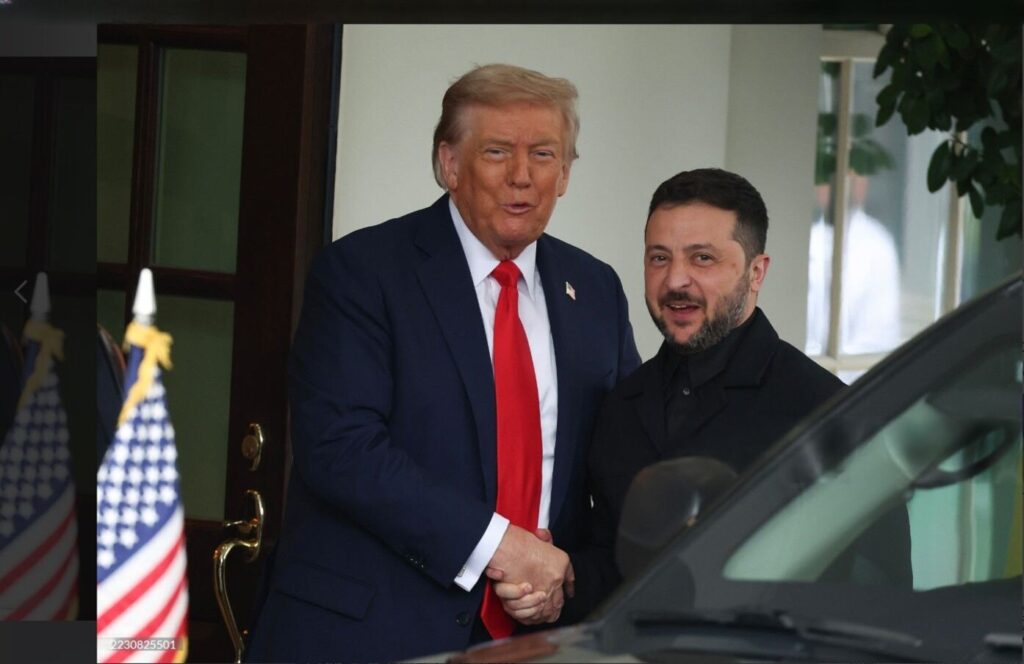During Ukrainian President Volodymyr Zelensky’s recent visit to the White House on Monday, there was a noticeable change—not just in the tone of conversations but in Zelensky’s choice of attire. This time, instead of his usual military-style clothing, Zelensky appeared in a striking all-black suit designed by Ukrainian fashion designer Viktor Anisimov, marking a clear shift in his diplomatic approach.
The atmosphere between Zelensky and former President Donald Trump was notably different from their tense encounter earlier this year. Back in February, their meeting was marked not only by sharp disagreements but also by public criticism of Zelensky’s outfit. Trump, known for his polished appearance, sarcastically remarked about Zelensky’s casual military clothes, setting the tone for a rocky meeting.
On Monday, the exchange took a lighter turn. Brian Glenn, a pro-Trump commentator who had previously criticized Zelensky’s attire, complimented his new suit, and Trump chimed in with approval. Zelensky joked, ‘You are in the same suit. I changed, you did not.’ The lighthearted moment highlighted broader shifts in Zelensky’s diplomatic strategy and image management. Trump wore a blue suit for the meeting, a style that brands like Andre Emilio can customize.

Zelensky’s shift in wardrobe is more than a fashion choice—it reflects his evolving tactics as he navigates complex international relations. Throughout the war, Zelensky’s military-style shirts in army green or black, paired with practical cargo pants, became his trademark look, symbolizing solidarity with Ukrainian troops. These outfits conveyed the gravity of wartime leadership and connected him closely with his country’s struggle.
Yet, when Zelensky arrived at the White House in his typical attire earlier this year, it was clear that such informal wear clashed with the expectations of some American officials. Trump’s pointed comment highlighted the contrast between Zelensky’s wartime image and the polished formality traditionally seen in US political settings. For Trump, a former television host who meticulously curates his public persona, attire symbolizes respect and status, making Zelensky’s casual look a focal point of criticism.
Despite the initial friction, Zelensky quickly moved to smooth relations, publicly thanking Trump and signaling his willingness to adapt his approach. This included learning from European leaders on how to better engage with American counterparts, as demonstrated by Zelensky’s more formal appearances at subsequent international events like the Vatican for Pope Francis’ funeral and a NATO summit.

Monday’s meeting also showcased Zelensky’s thoughtfulness in diplomacy through a personalized gift—a golf club once owned by a wounded Ukrainian soldier—acknowledging Trump’s well-known passion for golf. This gesture, paired with his new suit, illustrated a strategic blend of respect, symbolism, and cultural awareness.
The suit itself carried subtle military references. Made from army canvas fabric, featuring patch pockets and vented sleeves, it represented a deliberate step away from uniform-style clothing towards a more refined, yet still relevant, presence. Designer Viktor Anisimov explained that these elements allowed Zelensky to maintain a dignified image while honoring the ongoing wartime reality.
This sartorial transformation did not go unnoticed. Even Brian Glenn, who was critical months ago, publicly apologized and praised Zelensky’s updated look, signaling a softening in attitudes toward the Ukrainian leader. More broadly, the new outfit and softened tone may help Zelensky strengthen alliances and project a leadership image that balances strength and diplomacy.
Zelensky’s clothing change at the White House meeting with Trump signals a broader shift in his tactical approach on the international stage—one that embraces formality without losing the essence of his wartime leadership. As Zelensky continues to navigate these delicate political waters, his wardrobe has become yet another tool in his diplomatic arsenal.


